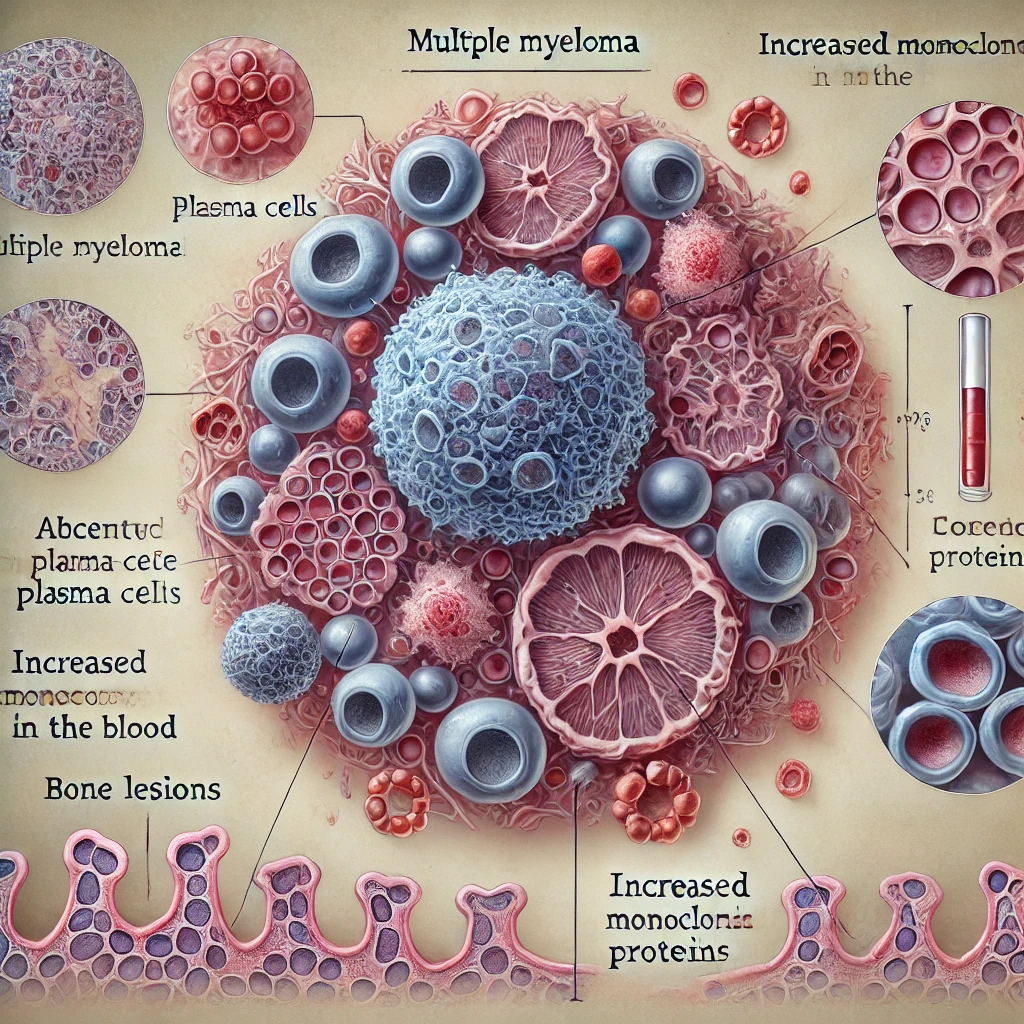What is Multiple Myeloma and What Are Its Symptoms

Multiple myeloma, a type of plasma cell neoplasm, is a blood cancer that originates in the bone marrow. In this condition, plasma cells, which typically function to help your body combat infections, begin to grow uncontrollably. This abnormal growth can lead to weakened bones, interfere with blood cell production, and place significant strain on your kidneys.
This plasma cell neoplasm predominantly impacts older adults, with most diagnoses occurring in individuals aged 65 and older. The average age at diagnosis is 69, and it is exceedingly rare in younger individuals, with less than 1% of cases found in those under 35. Early recognition of symptoms is crucial, as it can enhance outcomes and enable more effective management of multiple myeloma.
Key Takeaways
Multiple myeloma is a type of blood cancer. It mostly affects older people. Finding it early helps with better treatment and results.
Common signs are constant bone pain, tiredness from low red blood cells, and more infections. Spotting these signs early can help get quick treatment.
Kidney problems and high calcium levels can happen with this cancer. These can cause serious health issues. Talk to a doctor if you see swelling or changes in pee.
New treatments like CAR-T cell therapy and immunotherapy help people live longer. Learning about these treatments can help you feel more in control.
Joining support groups and using learning tools can be helpful. They give advice and support to handle multiple myeloma better.
Symptoms of Multiple Myeloma

Bone Damage
Bone pain and fractures
Bone pain is one of the most common early symptoms of multiple myeloma. You might feel persistent pain, especially in your back, ribs, or hips. This discomfort often worsens with movement or physical activity. Studies show that about 58% of patients report bone pain, with back pain being particularly frequent. In some cases, the disease weakens bones so much that fractures occur even with minor injuries. These are known as pathologic fractures and affect 26% to 34% of patients.
Weakened bones and osteoporosis
Multiple myeloma can cause your bones to lose density, leading to osteoporosis. This happens because the cancerous plasma cells interfere with normal bone remodeling, resulting in fragile bones. Approximately 85% of individuals with this condition experience some form of bone damage, such as osteolytic lesions or thinning bones. If you notice frequent fractures or a stooped posture, it could be a sign of weakened bones.
Blood-Related Symptoms
Anemia and fatigue
Anemia is another common symptom of multiple myeloma. It occurs when the overgrowth of plasma cells crowds out healthy red blood cells in your bone marrow. This type of anemia differs from others, such as iron deficiency anemia, because it stems directly from the cancer's impact on your blood production. You may feel unusually tired, weak, or short of breath. Fatigue affects about 32% of patients and can significantly impact daily life.
Increased risk of infections
Multiple myeloma can also lower your white blood cell count, making it harder for your body to fight infections. You might notice frequent colds, pneumonia, or other illnesses. This happens because the disease suppresses your immune system, leaving you more vulnerable. Infections are a common complication and can become severe if not addressed promptly.
Kidney Issues
Abnormal protein production affecting kidney function
The abnormal proteins produced by cancerous plasma cells can damage your kidneys. These proteins, known as monoclonal proteins or light chains, may form clumps (cast nephropathy) or deposit in kidney tissues, leading to conditions like amyloidosis. Up to 50% of patients with multiple myeloma develop kidney problems during the disease.
Symptoms like swelling and reduced urine output
Kidney damage can cause noticeable symptoms. You might experience swelling in your legs, ankles, or feet due to fluid retention. Reduced urine output or changes in urine color could also indicate kidney issues. If you notice these signs, it’s essential to consult a healthcare provider for further evaluation.
Other Symptoms
High calcium levels (hypercalcemia) causing nausea, confusion, or thirst
High calcium levels, also known as hypercalcemia, can occur when multiple myeloma disrupts normal bone metabolism. This condition causes calcium to leach from your bones into your bloodstream. You might notice symptoms like nausea, excessive thirst, or frequent urination. Confusion, irritability, or even drowsiness may also develop as calcium levels rise.
Hypercalcemia can become severe if left untreated. It may lead to dehydration or kidney damage. If you experience these symptoms, seek medical attention promptly. Addressing hypercalcemia early can prevent complications and improve your overall health.
Neurological symptoms like numbness or weakness
Multiple myeloma can also affect your nervous system. Peripheral neuropathy, a condition that damages nerves outside the brain and spinal cord, is a possible complication. You might feel numbness, tingling, or a "pins and needles" sensation in your hands or feet. Weakness in your limbs can also occur, making daily tasks more challenging.
In some cases, the disease may cause hyperviscosity, where your blood becomes thicker than normal. This can reduce blood flow to your brain, leading to confusion, dizziness, or stroke-like symptoms. Rarely, you might develop soft tissue masses or solitary bone tumors (plasmacytomas), which can press on nearby nerves and worsen neurological issues.
Note: If you notice persistent neurological symptoms, consult a healthcare provider. Early intervention can help manage these complications effectively.
Development and Progression of Multiple Myeloma
Precursor Conditions
MGUS (Monoclonal Gammopathy of Undetermined Significance)
MGUS is a condition where abnormal plasma cells produce monoclonal proteins in your blood. While it doesn’t cause symptoms, it serves as an early warning sign for multiple myeloma. About 3% of Americans aged 50 and older have MGUS. In high-risk groups, such as Black individuals or those with a family history of blood cancer, this number can rise to 14% or even 42%. Routine screening for MGUS isn’t common, so it’s often discovered during tests for other conditions.
Smoldering myeloma
Smoldering myeloma represents a stage between MGUS and active multiple myeloma. Unlike MGUS, smoldering myeloma carries a higher risk of progression. You might not experience symptoms during this stage, but regular monitoring is crucial. Early detection of smoldering myeloma can help identify patients who may benefit from preventive treatments.
Disease Progression
Transition from smoldering myeloma to active multiple myeloma
The transition from smoldering myeloma to active multiple myeloma occurs when the disease begins to cause symptoms or organ damage. This progression often involves an increase in abnormal plasma cells or monoclonal proteins. If you have smoldering myeloma, your doctor may monitor you closely to detect any signs of progression early.
Factors influencing disease progression
Several factors can influence the progression of smoldering myeloma to active multiple myeloma. These include:
Genetic mutations, which increase the risk of progression.
A higher percentage of abnormal plasma cells in your bone marrow.
Elevated levels of monoclonal proteins in your blood or urine.
Early intervention, especially for patients with genetic mutations, has shown promise in delaying or preventing the development of active multiple myeloma. Regular check-ups and advanced diagnostic tools can help you stay ahead of the disease.
Treatment Options for Multiple Myeloma

Standard Treatments
Chemotherapy and targeted therapy
Chemotherapy remains a cornerstone in treating multiple myeloma. It uses drugs like Doxil, Adriamycin, and Cytoxan to destroy cancerous plasma cells. These medications are often combined with other therapies to improve effectiveness. Targeted therapy, on the other hand, focuses on specific molecules involved in cancer growth. Monoclonal antibodies such as Darzalex and Empliciti enhance your immune system's ability to fight the disease. Steroids like dexamethasone are also commonly used to reduce inflammation and kill myeloma cells.
Here’s a table summarizing some effective treatments:
Treatment Type | Description |
|---|---|
Carvykti | Approved for patients who have received prior therapies, including a proteasome inhibitor and an immunomodulatory drug. |
Xpovio (selinexor) | A selective inhibitor of nuclear export, used with dexamethasone or Velcade for heavily pretreated patients. |
Maintenance Therapy | Continuous therapy post-induction to prevent recurrence, with Revlimid being a common option. |
Stem cell transplantation
Stem cell transplantation (SCT) offers another effective treatment option. Autologous SCT, where your own stem cells are used, is the standard for patients under 65 or those who can tolerate the procedure. This approach, combined with high-dose chemotherapy, has shown a median survival of 68 months. Patients who undergo early transplantation often experience longer progression-free survival compared to those who delay the procedure.
Median progression-free survival: 68 months (early transplantation) vs. 48 months (delayed).
Overall survival rate: Approximately 85% after a median follow-up of 76 months.
Supportive Treatments
Medications for bone health
Multiple myeloma often weakens bones, making supportive treatments essential. Bisphosphonates like Zometa and Aredia help strengthen bones and reduce the risk of fractures. Denosumab (Xgeva), a monoclonal antibody, also works to prevent skeletal-related events. In some cases, surgery or radiation therapy may be necessary to treat damaged bones or spinal fractures.
Common bone-supportive drugs:
Zometa (zoledronic acid)
Aredia (pamidronate)
Xgeva (denosumab)
Pain management and symptom relief
Managing pain is crucial for improving your quality of life. Pain medications, including over-the-counter and prescription options, can help alleviate discomfort caused by bone damage. Radiation therapy may also target specific areas of pain. For severe cases, surgical interventions like vertebroplasty can stabilize fractures and reduce pain.
Advancements in Care
Immunotherapy and CAR-T cell therapy
Immunotherapy has revolutionized the treatment of multiple myeloma. CAR-T cell therapy, which genetically modifies your immune cells to target cancer, has shown remarkable success. Recent FDA-approved therapies like Abecma and Carvykti target BCMA, a protein found on myeloma cells. Clinical trials are also exploring new CAR-T therapies aimed at GPRC5D, offering hope for patients with advanced disease.
Trial Name | Treatment | MRD Negativity Rate | Progression-Free Survival Rate |
|---|---|---|---|
PERSEUS | D-VRd | 84.3% at 48 months | |
CEPHEUS | D-VRd | 60% improvement | N/A |
Clinical trials and emerging treatments
Ongoing clinical trials continue to explore innovative therapies. New immunotherapies like Iberdomide and Cemsidomide are in development, targeting genetic mutations in myeloma cells. CAR-T therapies are also advancing, with a focus on combination treatments to improve outcomes. These emerging options aim to address unmet needs, particularly for high-risk patients or those with relapsed disease.
Prognosis for Multiple Myeloma Patients
Factors Affecting Prognosis
Stage of diagnosis
The stage at which you are diagnosed plays a critical role in determining your prognosis. Early-stage multiple myeloma often allows for more treatment options and better outcomes. Doctors use the Revised International Staging System (R-ISS) to evaluate the disease. This system considers biomarkers like beta-2-microglobulin and albumin levels, as well as genetic abnormalities. Early detection through effective diagnostic tools can help identify the disease before it progresses, giving you a better chance at managing it successfully.
Response to treatment
Your response to treatment significantly impacts your prognosis. Patients who respond well to therapies like chemotherapy, stem cell transplants, or immunotherapies often experience longer survival rates. Some individuals manage slow-growing forms of the disease for years, while others face more aggressive types. Advances in treatment have improved outcomes, but the variability in disease progression means that your response to therapy remains a key factor in determining your outlook.
Tip: Regular monitoring and follow-ups with your healthcare provider can help assess how well treatments are working and guide adjustments to your care plan.
Improvements in Survival Rates
Impact of new therapies
The introduction of innovative treatments has transformed the outlook for multiple myeloma patients. Therapies like CAR-T cell therapy and bispecific antibodies have significantly improved survival rates. These advancements have made achieving minimal residual disease (MRD)-negative outcomes more common, a milestone that was rare just a decade ago. Immunotherapies have also become essential in care, enhancing both longevity and quality of life. While high-risk patients still face challenges, new treatments offer hope for better outcomes and longer survival.
Importance of early detection
Catching multiple myeloma early can make a significant difference in your prognosis. Early identification allows you to access advanced treatments sooner, which can slow disease progression and improve survival rates. Diagnostic tools play a vital role in recognizing symptoms and confirming the disease. By addressing the condition early, you increase your chances of managing it effectively and maintaining a better quality of life.
Note: If you notice symptoms like persistent bone pain, fatigue, or frequent infections, consult a healthcare provider promptly. Early action can lead to better outcomes.
Support and Resources for Multiple Myeloma
Support Groups
Online communities and forums
Connecting with others who understand your journey can make a significant difference. Online communities provide a platform where you can share experiences, ask questions, and find encouragement. Some of the most active online spaces include:
HealthTree Foundation: This organization collaborates with the International Myeloma Foundation (IMF) to compile a list of support groups tailored to your needs.
The Cancer Society: Offers online forums where you can connect with survivors and other patients navigating similar challenges.
Joining these communities fosters peer-to-peer connections, helping you feel less isolated. They also serve as a valuable resource for learning about treatments and coping strategies.
Local support groups for patients and families
Local support groups bring people together in person, creating a sense of community. These groups reduce feelings of isolation by connecting you with others who truly understand your struggles. Participants often share tips on managing side effects or communicating with healthcare providers. This environment fosters mutual support and inspiration.
Attending local meetings can also be transformative. You gain access to educational platforms where you can learn about treatment options and share your journey. These shared experiences validate your feelings and empower you to face challenges with confidence.
Educational Resources
Websites and organizations dedicated to multiple myeloma
Reliable information is essential when managing multiple myeloma. Several trusted organizations provide educational resources and tools to help you stay informed:
HealthTree Foundation: Offers tools for clinical trials, specialist care, and community support.
Multiple Myeloma Research Foundation: Focuses on innovative treatments and provides clinical trial information.
National Cancer Institute: Delivers reliable cancer information and answers your questions through trained specialists.
American Cancer Society: Provides a 24/7 helpline for cancer-related inquiries.
OncoLink: Shares evidence-based cancer education for patients and healthcare professionals.
These websites empower you with knowledge, helping you make informed decisions about your care.
Patient advocacy groups
Advocacy groups play a vital role in supporting patients like you. They provide education and resources to help you understand your condition better. These groups also create a sense of community by connecting you with other patients and caregivers.
Many advocacy organizations host educational seminars and offer resources that guide you in asking the right questions during medical appointments. By empowering you with information and hope, they make navigating treatment options less overwhelming.
Multiple myeloma is a complex disease that often begins silently but can lead to significant health challenges. Symptoms like bone pain, fatigue, and increased infections develop over time, often signaling disease progression. The table below highlights the frequency of common symptoms:
Symptom | Incidence (%) |
|---|---|
Bone pain (especially back) | 58 |
Fatigue (from anemia) | 32 |
Pathologic fractures | 26 to 34 |
Weight loss | 24 |
Early detection plays a vital role in improving outcomes. Advanced treatments, such as CAR-T cell therapy and immunotherapy, offer hope for better survival rates. You can find strength in support groups and educational resources, which provide guidance and community. Taking action early can make a significant difference in managing this condition effectively.
#BanishCancer
FAQ
What causes multiple myeloma?
Scientists do not know the exact cause of multiple myeloma. However, certain factors like age, family history, and exposure to harmful chemicals may increase your risk. Genetic mutations in plasma cells also play a role in the development of this disease.
Is multiple myeloma curable?
Currently, there is no cure for multiple myeloma. However, treatments like chemotherapy, immunotherapy, and stem cell transplants can help you manage the disease. These therapies aim to control symptoms, slow progression, and improve your quality of life.
How is multiple myeloma diagnosed?
Doctors use blood tests, urine tests, and imaging scans to diagnose multiple myeloma. A bone marrow biopsy confirms the presence of abnormal plasma cells. Early diagnosis improves treatment outcomes, so consult your doctor if you notice symptoms like bone pain or fatigue.
Can lifestyle changes help manage multiple myeloma?
Yes, adopting a healthy lifestyle can support your treatment. Eating a balanced diet, staying active, and managing stress can improve your overall well-being. Always discuss lifestyle changes with your healthcare provider to ensure they align with your treatment plan.
What is the life expectancy for someone with multiple myeloma?
Life expectancy varies based on factors like the stage of diagnosis and response to treatment. Advances in therapies have improved survival rates significantly. Many patients live for several years after diagnosis, especially with early detection and effective care.
See Also
Understanding Leiomyosarcoma: Key Symptoms to Watch For
Hodgkin's Lymphoma Explained: Identifying Its Symptoms
Follicular Lymphoma Overview: Recognizing Common Symptoms
Chronic Myelogenous Leukemia: Symptoms and Underlying Causes
Burkitt's Lymphoma: Understanding Symptoms and Characteristics
